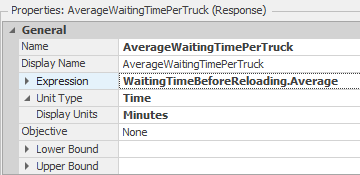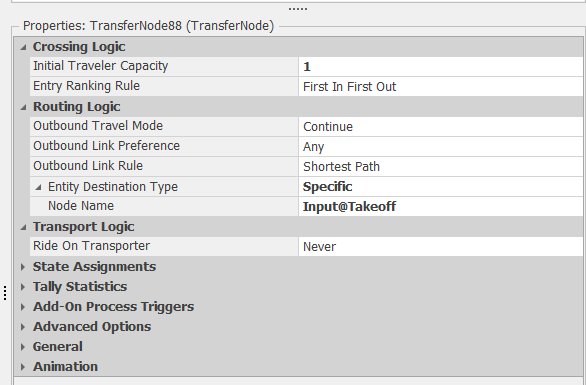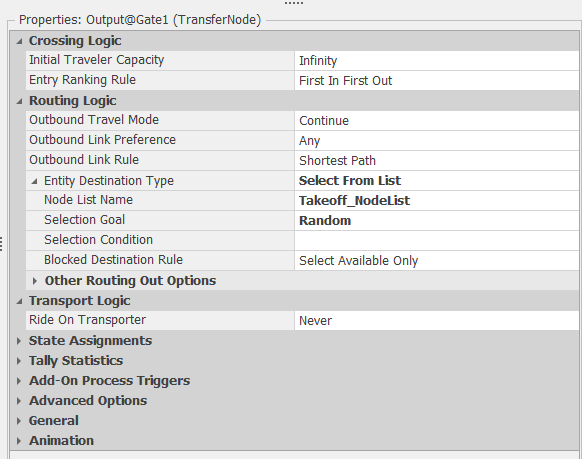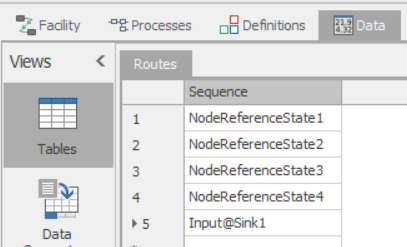Search the Community
Showing results for 'sink percentage of entities'.
-
Hello everyone, I'm thrilled to share that I've successfully established my simulation model and conducted extensive verification and validation. Now, I'm ready to take the next exciting step: experimentation! While I've made considerable progress, I've encountered a minor setback. It seems that for certain scenarios, the response 'AverageWaitingTimePerTruck' isn't displaying any values. Interestingly enough, this issue only arises when conducting experiments with higher throughput values. The response is defined by averaging the tally statistic 'WaitingTimeBeforeReloading' of the Truck Entities in my model. Have any of you experienced a similar situation before? If so, I would greatly appreciate your insights on resolving this matter. Thank you in advance for your support! Best regards, Toon
-
Hi, I have 6 entities arriving at exactly 8am each day. Each of the 6 entities will create a certain number of entities on arrival from their respective distributions. How do I model in my source? I cannot have multiple sources as each entity has its own server processing times. Please can you help? Thank you
-
Hi all, I am building a simulation of a system with multiple separators which MemberOutput nodes two different routing policies can occur: 1. Standard Policy In the 'Standard Policy', each separator has its dedicated transporter assigned to it and entities arriving at the MemberOutputNode can only select the defined transporter. To this end, a DataTable has been constructed. 2. Power Hour policy In the 'Power Hour Policy', operations are shifted into a higher gear. We select a maximum number of three nearest transporters whose ride request is 0 and include them in the DataTable which specifies the Transporter Selection. Entities arriving at the MemberOutputNode can now request rides from any transporter in the DataTable. I tried to reference to a DataTable called 'TransporterSelection.EPT' in the Transport Logic of each MemberOutput Node. Each value in the EPT column is cross-referencing to a DataTable in which I try to assign the MemberInput Nodes as a Node Reference State Variable of the Transporter (EPT). Is there any way to dynamically assign more (or less for that matter) Transporters to a TransferNode? Hope that anyone knows how to do this! Cheers, Toon
-
I have a multiple combiners into which a single worker provides entities. While the worker is at a specific combiner, I want to check if that combiner's output buffer is full. I'd prefer not to create a separate process for each combiner as I have dozens. How do I code the process so that it is generic and that 1 process can work for any combiner? I'm hoping this is an easy question. Sorry if it's obvious. Thanks for your help.
-
Hello, I am writing my master thesis on production system design with simulation modeling. I have designed two models in Simio - one for current production system and one for optimized one. They are both designed in a correct way and they work as they are supposed to. The only difference between them is in path lengths. The difference between results from optimized and current system should be 3 - 5 % but for some reason I get all of the results identical to the last decimal place after running an experiment. I have attached a picture of my path properites and travel logic of entities. My guess is that for some reason path length is not being considered in the simulation. If anybody has any ideas what could be wrong, i would really appreciate your help.
-
FullGate version 17 (both side take off).spfx We encounter few problems: 1. Why the plane( entities) only go to one side for waiting to take off but not both side used? 2. Any fomular can i add into the simio? The plane will choose which path to go on the taxiway. Such as the plane on the Node 82 if the taxiway A(path 179) had 3 plane waiting but taxiway B (Path 160) had 1 plane waiting, than the plane will choose taxiway B to wait for take off. Gate.xlsx 30 Departure.xlsx
-
Hello River, I downloaded your files. The Gate512 was missing. I removed the information in the "30 Departure.xlxs" file that I can run the model ;-). Generally I understood how it works. Answer to your first question: I think you mean these two ways, right? From the left and from the right. In this case I saw that you used the "Routing Logic" in like all Transfernodes. The Outbound Link Rule is "Shortest Path" and you set the "Node Name" to "Input@Takeoff" Simio is using everytime the shortest link path now. Like in the screenshot below: In my opinion it would be better to set the destination once after the Entity got created in the Source for example :-). There are different ways to do that. In your model I removed all Routing Logic in the Transfernodes and used the Routing Logic only in the Output-TransferNodes of the Sources. In Simio you need only to use one time a SetNode-Step or a Routing-Logic to set the destination of an Entitiy and Simio will follow the paths or travel in the FreeSpace. You can use for example a NodeList with 2 different destinations and this Routing-Logic: With the "Selection Goal" Random Simio will randomly choose the destination from the NodeList. I uploaded you your model with the changes as an example: Problem on the taxiway version 17A.zip What did I changed? 1) I removed the Routing Logic in all TransferNodes. 2) I added new Routing Logic to the TransferNodes of the Output-Node of the Sources. 3) I added a NodeList with 2 new Nodes. 4) In the two new Nodes I used a Nodes-Entered-Process and a Transfer-Step to transfer the Entity to the Input of the Sink. Answer to your second question: You can change the destination of an Entity any time. In the Path (Link) you have a function called "NumberTravelors" for example to get the number of travelors currently on this path. So you can use a Expression like "Path123.NumberTravelors < 2". This can be used to decide if a way is full allready that the other way get selected. Or you can use a Integer-State and count up and down. I would use a Node-Entered-Process in the last possible node with a Decide-Step and two SetNode-Step in this case :-). I hope my answer will help you. When you have any other question, you are welcome! Best regards Pascal
-
Hi I want my simulation to start with some entities at the output node of a server. Is that possible? Thanks in advance Janus
-
Well, there are two problems in your model: First, there are many gates that are not following the data table. Second: every gate should be on the Gate table, regardless if they will have flights or not. If not, they will create entities on every single arrival of the departure table. You have many gates that are not included on Gate table.
-

Changing Sequence table over time
dsturrock replied to antonio6vieira's topic in SI General Discussions
I have attached a simple model using model states to illustrate. I think it should work in a similar fashion using entity states. First, I define the states: Then use those states as Sequence destinations: Until you provide each of those states a value, the Sequence will make no sense and the entity won't know where to go. So on the Source I use an Assign to initialize all the values. This will direct the entity sequentially through Servers 1-4, and then to the Sink: Finally, just to illustrate the technique, on the output node of Server3, I interrupt the normal sequence by Assigning it to instead go to Server5 as its 4th step: If you convert these states to Entity states instead (I was just lazy), I think it should work the same but allow you to selectively override any Sequence Step at any time. UsingStatesInSequences.spfx -
Hi David, I am trying to get your option 3 to work in my model, as the solutions sounds brilliant. I created an Add-On Process that probabilistically assigns destinations to the Entity and by assigning the destination node to the Entity's State Variable MyDest. In the Routing Logic, I've set the Initial Sequence to the sequence table called Routes that holds all possible routes. However, the entities now only follow the first sequence Routes (Input@LoadingDock9, Input@Sink_HTB), whereas Entities with the destination Input@Sink_RTM should follow the sequence Input@LoadingDock10, Input@Sink_RTM. How can I let the Entity follow a specific sequence from my Sequence Table Routes?
-
I am very new to simio and need to create a model for a class. My problem statement is based on services provided by a cafetería. I have 3 types of clients, with their respective proportions. Additionally, each client has their own sequence. I have already made a data table with the proportions and a sequence table for each client. After the clients finish their sequence, every client goes to the same sink (which represents the cashier). What I don't know how to do is show how that sink can provide two types of services: credit cards and cash. On top of that, the credit card service must be 63% of the total entities that go into the system. I will really appreciate any help you can give me!
-
Server Capacity Depends on # of Seized Resources
Liz Millar replied to nObeso23's topic in SI General Discussions
Hi Nicolas, I would investigate the Server property called Initial Capacity. This sets how many units of capacity are going to be available for the Server. You could also change this during the run by Assigning the Server's CurrentCapacity State Variable. I suggest checking out the SimBit titled "Worker Uses Work Schedule". You can access the SimBits in the Support ribbon in Simio. In this SimBit, I recommend changing the Initial Capacity for the Servers. You could set them to '6' or any value. When you run, you will see that the entities only move into the Process Station when they have successfully Seized the Secondary Resource. So even though there is 6 units available only 1 will be use when the Worker is able to process the entity. You can also experiment with giving the Worker a different Initial Number In System value so there can be more Workers. You will still see the same behavior; the number of entities that move into the Server for processing will be the number of Workers that were available to be seized. Happy Modeling! Liz -
Hi all, I am working on a building evacuation project through Simio. I want to know how can I block a sink object, so entities can not exit through that sink. I also need to know if I can somehow define this situation in referenced property under Experiment and try different scenarios. For example in each scenario I block one of the exits and monitor the number exited (survivors) or evacuation time. My other problem is simulating fire with different rates and interaction of it with the entities, as when they see fire they avoid running toward that direction and change the route. Thank you for your help,
-
This is problematic in Simio because Simio considers only entity length (not width) and only when on a Path or Conveyor. I think the first thing to do is fix the nose to tail problem. If you happen to use Conveyors to model this, there are built-in features to manage spacing while stopped and different spacing while moving. But unfortunately Conveyors are limited to a single direction, so are perhaps not appropriate if this is a bi-directional taxiway. If you are using Paths, you can fix this by making each plane longer when you draw it. For example, if you are drawing a plane that is 50M long and you want it to stay at least 10M behind the plane in front of it, place a nearly invisible dot about 10M in front of the plane's nose, making the total plane length (including safety spacing) be 60M. Although Simio will still put the entities nose to tail, there will be a 10M safety spacing between the physical planes. The problem of conflict at merge points is a bit more tedious to fix. I'd recommend a resource-based approach, like illustrated in the SimBit in Merging Conveyors Controlled by Gate. You can use this approach even when using Paths.
-
I have a model with several vehicles transporting different amount of entities. I would like to know the average amount of entities a vehicle transports during one tour. So there is only one TransferNode where the vehicles can load the entities and then they start to their tour and come back to the TransferNode. The best way would be to know the amount of entities a vehicles loads on average on this TransferNode.I need the average value for each vehicle measured over the whole simulation run. But i have no idea how to do that. I would appreciate any suggestions. Thank you very much.
-
Hi All, is there a way to make the server waiting for two (or any defined number) entities to begin the processing? I would like the server to begin processing only when two entities has arrived. Then the two entities leaves the server at the same time, and other two begin being processed. Can I do it without defining a process?
-
Hi I need reference to some sort of property that can help me store entities in my transfer node(shelf). I have used the Park property but then I am not sure on how I can release it when the transporter is told to arrive at the transfer node(shelf) to pick up certain of those parked entities. Any help is appreciated. Thank you
-
Hello, I have a Arrival Table, but I only want to create Entities of a specific part of the Table based on a property. IntCol Entity 0 A 0 C 1 B 1 c So, the source should create all entities with a certain integer in column 'IntCol'. The integer value is assigned by a referenced property that I can experiment with different parts of the ArrivalTable For example: If Property == 0 , create only A and C in the source. How can I do that? All the best
-
Design of Experiments with Import Table
Grant S replied to Grant S's topic in SI General Discussions
Thank you for responding - in that configuration, does that mean I need 100 excel sheets? Right now, I have 100 rows that have the different experiments I want to run, and all the values needed for the node-lists / transporter-lists and entities to be used Thanks for your help!- 5 replies
-
- table referencing
- experiment dashboards
-
(and 1 more)
Tagged with:
-
How to increase the distence between entity to entity ?
ViniciusF replied to River's topic in SI General Discussions
To make an entity wait until the runway is free what you could do is set the Initial Traveler Capacity of the Runway path to 1. This way entities will wait at the node before entering the path. I did not understand the first question, but if you need entities to visually appear behind one another, set Allow Passing to False on the path. Alternatively, you could use conveyor instead of path to make entities allign and respect some distance. Hope it helps. -
I am trying to model a repair process. A major part of this process is the time to get the tools from their storage locations to the machine that needs repair. My thought was to have the tools be modeled as entities that a fork lift or worker has to go grab and bring back to the server. The problem is I need to wait for all those entities to be there before the server can start to process. Then I want to destroy the entities because they aren't actually being processed (only 1 entity would be processed as a representation). Does anyone have a suggestion on how this might be accomplished? Thanks.
-
Hello! So I am using a source that is sending out 9 different entities, each with a priority 1-9. They are listed in a Data table called 'Part Data' This is the 'Table Row Referencing' call I am using in 'Before Creating Entities' in the 'Row Number' section: PartData.Priority.RandomRow I want to switch this to use a Random.Normal(mean, sd) - is that possible with discrete values in the table? Thank you for any help you can provide!
-
Hi to all! I am currently working on a project in which it would be desirable to show a container yard with stacked container entities, limited up to 5 containers per column of stacked entities. I have worked with queues associated to both servers and storage/station items, and found that it is possible to emulate what I want to do, but that the height of every single container must be defined by a hand-drawing process, which is a time-consuming task. Is there a way to create a container yard and to define it's properties? I have read in the forums some answers to similar problems stating that "a storage element will suffice", but it seems to me that I am failing to see how to manifest physically in the model the container yard with the restrictions mentioned above (at most I have been able to show the contents of the storage/station element on a queue line). Any hints, tips, or comments would be deeply appreciated. Cheers!
-
Hi, I have several sources that create the same container entity, yet every container entity created carries out different tasks throughout the model. I would like to change properties of specific container entities, for example, each time the container entity in "lane 1" gets filled, it changes the speed of that container entity (not of all the population of container entities). How can I do this? Thank you!!!


















